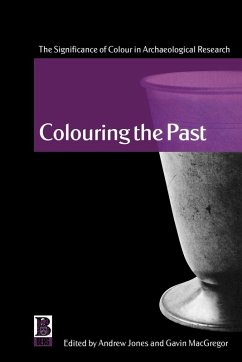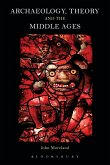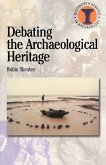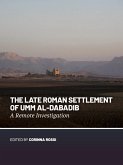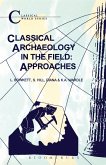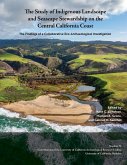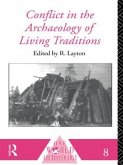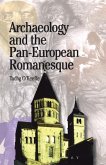European Association Of Archaeologists, European Association Of ArchaeologistsThe Significance of Colour in Archaeological Research
Colouring the Past
The Significance of Colour in Archaeological Research
Herausgeber: Jones, Andrew
European Association Of Archaeologists, European Association Of ArchaeologistsThe Significance of Colour in Archaeological Research
Colouring the Past
The Significance of Colour in Archaeological Research
Herausgeber: Jones, Andrew
- Broschiertes Buch
- Merkliste
- Auf die Merkliste
- Bewerten Bewerten
- Teilen
- Produkt teilen
- Produkterinnerung
- Produkterinnerung
Colour shapes our world in profound, if sometimes subtle, ways. It helps us to classify, form opinions, and make aesthetic and emotional judgements. Colour operates in every culture as a symbol, a metaphor, and as part of an aesthetic system. Yet archaeologists have traditionally subordinated the study of colour to the form and material value of the objects they find and thereby overlook its impact on conceptual systems throughout human history.This book explores the means by which colour-based cultural understandings are formed, and how they are used to sustain or alter social relations. From…mehr
Andere Kunden interessierten sich auch für
![Archaeology, Theory and the Middle Ages Archaeology, Theory and the Middle Ages]() John MorelandArchaeology, Theory and the Middle Ages57,99 €
John MorelandArchaeology, Theory and the Middle Ages57,99 €![Debating the Archaeological Heritage Debating the Archaeological Heritage]() Robin SkeatesDebating the Archaeological Heritage36,99 €
Robin SkeatesDebating the Archaeological Heritage36,99 €![The Late Roman Settlement of Umm al-Dabadib The Late Roman Settlement of Umm al-Dabadib]() The Late Roman Settlement of Umm al-Dabadib46,99 €
The Late Roman Settlement of Umm al-Dabadib46,99 €![Classical Archaeology in the Field Classical Archaeology in the Field]() Laurence BowkettClassical Archaeology in the Field31,99 €
Laurence BowkettClassical Archaeology in the Field31,99 €![The Study of Indigenous Landscape and Seascape Stewardship on the Central California Coast The Study of Indigenous Landscape and Seascape Stewardship on the Central California Coast]() The Study of Indigenous Landscape and Seascape Stewardship on the Central California Coast65,99 €
The Study of Indigenous Landscape and Seascape Stewardship on the Central California Coast65,99 €![Conflict in the Archaeology of Living Traditions Conflict in the Archaeology of Living Traditions]() R. Layton (ed.)Conflict in the Archaeology of Living Traditions70,99 €
R. Layton (ed.)Conflict in the Archaeology of Living Traditions70,99 €![Archaeology and the Pan-European Romanesque Archaeology and the Pan-European Romanesque]() T. O'KeefeArchaeology and the Pan-European Romanesque35,99 €
T. O'KeefeArchaeology and the Pan-European Romanesque35,99 €-
-
-
Colour shapes our world in profound, if sometimes subtle, ways. It helps us to classify, form opinions, and make aesthetic and emotional judgements. Colour operates in every culture as a symbol, a metaphor, and as part of an aesthetic system. Yet archaeologists have traditionally subordinated the study of colour to the form and material value of the objects they find and thereby overlook its impact on conceptual systems throughout human history.This book explores the means by which colour-based cultural understandings are formed, and how they are used to sustain or alter social relations. From colour systems in the Mesolithic, to Mesoamerican symbolism and the use of colour in Roman Pompeii, this book paints a new picture of the past. Through their close observation of monuments and material culture, authors uncover the subtle role colour has played in the construction of past social identities and the expression of ancient beliefs. Providing an original contribution to our understanding of past worlds of meaning, this book will be essential reading for archaeologists, anthropologists and historians, as well as anyone with an interest in material culture, art and aesthetics.
Produktdetails
- Produktdetails
- Verlag: Berg 3PL
- Seitenzahl: 276
- Erscheinungstermin: 1. Juli 2002
- Englisch
- Abmessung: 234mm x 156mm x 15mm
- Gewicht: 424g
- ISBN-13: 9781859735473
- ISBN-10: 1859735479
- Artikelnr.: 22283362
- Herstellerkennzeichnung
- Libri GmbH
- Europaallee 1
- 36244 Bad Hersfeld
- gpsr@libri.de
- Verlag: Berg 3PL
- Seitenzahl: 276
- Erscheinungstermin: 1. Juli 2002
- Englisch
- Abmessung: 234mm x 156mm x 15mm
- Gewicht: 424g
- ISBN-13: 9781859735473
- ISBN-10: 1859735479
- Artikelnr.: 22283362
- Herstellerkennzeichnung
- Libri GmbH
- Europaallee 1
- 36244 Bad Hersfeld
- gpsr@libri.de
Andrew Jones Lecturer in Archaeology,University of Southampton Gavin MacGregor Project Officer, Archaeological Research Division, University of Glasgow
Preface Introduction: Wonderful things: colour studies in archaeology from
Munsell to materiality Andrew Jones and Gavin MacGregor 1. Apotropaism and
the temporality of colours: colourful Mesolithic-Neolithic seasons in the
Danube Gorges Dusan Boriç 2. Colourful prehistories: the problem with the
Berlin and Kay colour paradigm John Chapman 3. White on blonde: quartz
pebbles and the use of quartz at Neolithic monuments in the Isle of Man and
beyond Timothy Darvill 4. So many shades of rock: colour symbolism and
Irish stone axeheads Gabriel Cooney 5. The Flashing Blade: copper, colour
and luminosity in north Italian Copper Age society Stephen Keates 6.
Munselling the Mound: the use of soil colour as metaphor in British Bronze
Age Funerary ritual Mary-Ann Owoc 7. Making monuments out of mountains: the
role of colour and texture in the constitution of meaning and identity at
Recumbent Stone Circles Gavin MacGregor 8. A biography of colour: colour,
material histories and personhood in the Early Bronze Age of Britain and
Ireland Andrew Jones 9. The composition, function and significance of the
mineral paints from the Kurgan burial mounds of the South Urals and North
Kazakhstan Alexander Tairov and A. F Bushamakin 10. Colour and light in a
Pompeian house: modern impressions or ancient perceptions Penelope M.
Allison 11. The colours of light: materiality and chromatic cultures of the
Americas Nicholas J. Saunders 12. Epilogue: colour and materiality in
prehistoric society Chris Scarre NOTES ON CONTRIBUTORS Penelope M. Allison
has taught ancient history and archaeology at the University of Sydney
(Australia), the Australian National University and the University of
Sheffield (UK). She has held research fellowships at the University of
Sydney (Australia) and in the Faculty of Classics, Cambridge (UK). She is
currently an Australian Research Council Queen Elizabeth II Fellow at the
Australian National University. She has recently edited The Archaeology of
Household Activities (Routledge 1999) and co-authored Casa della Caccia
Antica, for the series Häuser in Pompeji (Hirmer, Munich) and authored
Pompeian Households (The Cotsen Institute of Archaeology at UCLA). Dusan
Boric is currently completing his doctoral research on the topic of
'Mesolithic-Neolithic time views: seasons and life cycles in the Balkans,
c. 9000-5500 BC ' in the Department of Archaeology, University of Cambridge
(UK). His current research focuses on the Early Holocene archaeological
sequences of the Danube Gorges of Serbia and the sites of Lepenski Vir,
Padina, Vlasac and Hajducka Vodenica with an emphasis on subsistence
practices, mortuary data and domestic architecture. He is interested in
exploring theoretical aspects of archaeological inquiry that can contribute
to the wider field of social theory. These include questions of
apotropaism, temporality and the political nature of archaeological
practice. The late Anatoli Filippovich Bushmakin worked at the Institute of
Mineralogy, Urals Branch of the Russian Academy of Science (Russia) in
collaboration with Alexander Tairov. Gabriel Cooney is a Professor in the
Department of Archaeology, University College Dublin (Ireland). He is the
author of numerous articles on the Irish Neolithic, landscape archaeology
and archaeological theory. He recently published 'Landscapes of Neolithic
Ireland' (Routledge, 2000). John Chapman is a Reader in Archaeology in the
University of Durham (UK) with research interests in archaeological theory,
settlement, mortuary studies and social structure. He has worked for over
30 years with the Mesolithic, Neolithic and Copper Age of Central and
Eastern Europe. He recently published a ground-breaking book 'Fragmentation
in archaeology' (Routledge, 2000). His late
Munsell to materiality Andrew Jones and Gavin MacGregor 1. Apotropaism and
the temporality of colours: colourful Mesolithic-Neolithic seasons in the
Danube Gorges Dusan Boriç 2. Colourful prehistories: the problem with the
Berlin and Kay colour paradigm John Chapman 3. White on blonde: quartz
pebbles and the use of quartz at Neolithic monuments in the Isle of Man and
beyond Timothy Darvill 4. So many shades of rock: colour symbolism and
Irish stone axeheads Gabriel Cooney 5. The Flashing Blade: copper, colour
and luminosity in north Italian Copper Age society Stephen Keates 6.
Munselling the Mound: the use of soil colour as metaphor in British Bronze
Age Funerary ritual Mary-Ann Owoc 7. Making monuments out of mountains: the
role of colour and texture in the constitution of meaning and identity at
Recumbent Stone Circles Gavin MacGregor 8. A biography of colour: colour,
material histories and personhood in the Early Bronze Age of Britain and
Ireland Andrew Jones 9. The composition, function and significance of the
mineral paints from the Kurgan burial mounds of the South Urals and North
Kazakhstan Alexander Tairov and A. F Bushamakin 10. Colour and light in a
Pompeian house: modern impressions or ancient perceptions Penelope M.
Allison 11. The colours of light: materiality and chromatic cultures of the
Americas Nicholas J. Saunders 12. Epilogue: colour and materiality in
prehistoric society Chris Scarre NOTES ON CONTRIBUTORS Penelope M. Allison
has taught ancient history and archaeology at the University of Sydney
(Australia), the Australian National University and the University of
Sheffield (UK). She has held research fellowships at the University of
Sydney (Australia) and in the Faculty of Classics, Cambridge (UK). She is
currently an Australian Research Council Queen Elizabeth II Fellow at the
Australian National University. She has recently edited The Archaeology of
Household Activities (Routledge 1999) and co-authored Casa della Caccia
Antica, for the series Häuser in Pompeji (Hirmer, Munich) and authored
Pompeian Households (The Cotsen Institute of Archaeology at UCLA). Dusan
Boric is currently completing his doctoral research on the topic of
'Mesolithic-Neolithic time views: seasons and life cycles in the Balkans,
c. 9000-5500 BC ' in the Department of Archaeology, University of Cambridge
(UK). His current research focuses on the Early Holocene archaeological
sequences of the Danube Gorges of Serbia and the sites of Lepenski Vir,
Padina, Vlasac and Hajducka Vodenica with an emphasis on subsistence
practices, mortuary data and domestic architecture. He is interested in
exploring theoretical aspects of archaeological inquiry that can contribute
to the wider field of social theory. These include questions of
apotropaism, temporality and the political nature of archaeological
practice. The late Anatoli Filippovich Bushmakin worked at the Institute of
Mineralogy, Urals Branch of the Russian Academy of Science (Russia) in
collaboration with Alexander Tairov. Gabriel Cooney is a Professor in the
Department of Archaeology, University College Dublin (Ireland). He is the
author of numerous articles on the Irish Neolithic, landscape archaeology
and archaeological theory. He recently published 'Landscapes of Neolithic
Ireland' (Routledge, 2000). John Chapman is a Reader in Archaeology in the
University of Durham (UK) with research interests in archaeological theory,
settlement, mortuary studies and social structure. He has worked for over
30 years with the Mesolithic, Neolithic and Copper Age of Central and
Eastern Europe. He recently published a ground-breaking book 'Fragmentation
in archaeology' (Routledge, 2000). His late
Preface Introduction: Wonderful things: colour studies in archaeology from
Munsell to materiality Andrew Jones and Gavin MacGregor 1. Apotropaism and
the temporality of colours: colourful Mesolithic-Neolithic seasons in the
Danube Gorges Dusan Boriç 2. Colourful prehistories: the problem with the
Berlin and Kay colour paradigm John Chapman 3. White on blonde: quartz
pebbles and the use of quartz at Neolithic monuments in the Isle of Man and
beyond Timothy Darvill 4. So many shades of rock: colour symbolism and
Irish stone axeheads Gabriel Cooney 5. The Flashing Blade: copper, colour
and luminosity in north Italian Copper Age society Stephen Keates 6.
Munselling the Mound: the use of soil colour as metaphor in British Bronze
Age Funerary ritual Mary-Ann Owoc 7. Making monuments out of mountains: the
role of colour and texture in the constitution of meaning and identity at
Recumbent Stone Circles Gavin MacGregor 8. A biography of colour: colour,
material histories and personhood in the Early Bronze Age of Britain and
Ireland Andrew Jones 9. The composition, function and significance of the
mineral paints from the Kurgan burial mounds of the South Urals and North
Kazakhstan Alexander Tairov and A. F Bushamakin 10. Colour and light in a
Pompeian house: modern impressions or ancient perceptions Penelope M.
Allison 11. The colours of light: materiality and chromatic cultures of the
Americas Nicholas J. Saunders 12. Epilogue: colour and materiality in
prehistoric society Chris Scarre NOTES ON CONTRIBUTORS Penelope M. Allison
has taught ancient history and archaeology at the University of Sydney
(Australia), the Australian National University and the University of
Sheffield (UK). She has held research fellowships at the University of
Sydney (Australia) and in the Faculty of Classics, Cambridge (UK). She is
currently an Australian Research Council Queen Elizabeth II Fellow at the
Australian National University. She has recently edited The Archaeology of
Household Activities (Routledge 1999) and co-authored Casa della Caccia
Antica, for the series Häuser in Pompeji (Hirmer, Munich) and authored
Pompeian Households (The Cotsen Institute of Archaeology at UCLA). Dusan
Boric is currently completing his doctoral research on the topic of
'Mesolithic-Neolithic time views: seasons and life cycles in the Balkans,
c. 9000-5500 BC ' in the Department of Archaeology, University of Cambridge
(UK). His current research focuses on the Early Holocene archaeological
sequences of the Danube Gorges of Serbia and the sites of Lepenski Vir,
Padina, Vlasac and Hajducka Vodenica with an emphasis on subsistence
practices, mortuary data and domestic architecture. He is interested in
exploring theoretical aspects of archaeological inquiry that can contribute
to the wider field of social theory. These include questions of
apotropaism, temporality and the political nature of archaeological
practice. The late Anatoli Filippovich Bushmakin worked at the Institute of
Mineralogy, Urals Branch of the Russian Academy of Science (Russia) in
collaboration with Alexander Tairov. Gabriel Cooney is a Professor in the
Department of Archaeology, University College Dublin (Ireland). He is the
author of numerous articles on the Irish Neolithic, landscape archaeology
and archaeological theory. He recently published 'Landscapes of Neolithic
Ireland' (Routledge, 2000). John Chapman is a Reader in Archaeology in the
University of Durham (UK) with research interests in archaeological theory,
settlement, mortuary studies and social structure. He has worked for over
30 years with the Mesolithic, Neolithic and Copper Age of Central and
Eastern Europe. He recently published a ground-breaking book 'Fragmentation
in archaeology' (Routledge, 2000). His late
Munsell to materiality Andrew Jones and Gavin MacGregor 1. Apotropaism and
the temporality of colours: colourful Mesolithic-Neolithic seasons in the
Danube Gorges Dusan Boriç 2. Colourful prehistories: the problem with the
Berlin and Kay colour paradigm John Chapman 3. White on blonde: quartz
pebbles and the use of quartz at Neolithic monuments in the Isle of Man and
beyond Timothy Darvill 4. So many shades of rock: colour symbolism and
Irish stone axeheads Gabriel Cooney 5. The Flashing Blade: copper, colour
and luminosity in north Italian Copper Age society Stephen Keates 6.
Munselling the Mound: the use of soil colour as metaphor in British Bronze
Age Funerary ritual Mary-Ann Owoc 7. Making monuments out of mountains: the
role of colour and texture in the constitution of meaning and identity at
Recumbent Stone Circles Gavin MacGregor 8. A biography of colour: colour,
material histories and personhood in the Early Bronze Age of Britain and
Ireland Andrew Jones 9. The composition, function and significance of the
mineral paints from the Kurgan burial mounds of the South Urals and North
Kazakhstan Alexander Tairov and A. F Bushamakin 10. Colour and light in a
Pompeian house: modern impressions or ancient perceptions Penelope M.
Allison 11. The colours of light: materiality and chromatic cultures of the
Americas Nicholas J. Saunders 12. Epilogue: colour and materiality in
prehistoric society Chris Scarre NOTES ON CONTRIBUTORS Penelope M. Allison
has taught ancient history and archaeology at the University of Sydney
(Australia), the Australian National University and the University of
Sheffield (UK). She has held research fellowships at the University of
Sydney (Australia) and in the Faculty of Classics, Cambridge (UK). She is
currently an Australian Research Council Queen Elizabeth II Fellow at the
Australian National University. She has recently edited The Archaeology of
Household Activities (Routledge 1999) and co-authored Casa della Caccia
Antica, for the series Häuser in Pompeji (Hirmer, Munich) and authored
Pompeian Households (The Cotsen Institute of Archaeology at UCLA). Dusan
Boric is currently completing his doctoral research on the topic of
'Mesolithic-Neolithic time views: seasons and life cycles in the Balkans,
c. 9000-5500 BC ' in the Department of Archaeology, University of Cambridge
(UK). His current research focuses on the Early Holocene archaeological
sequences of the Danube Gorges of Serbia and the sites of Lepenski Vir,
Padina, Vlasac and Hajducka Vodenica with an emphasis on subsistence
practices, mortuary data and domestic architecture. He is interested in
exploring theoretical aspects of archaeological inquiry that can contribute
to the wider field of social theory. These include questions of
apotropaism, temporality and the political nature of archaeological
practice. The late Anatoli Filippovich Bushmakin worked at the Institute of
Mineralogy, Urals Branch of the Russian Academy of Science (Russia) in
collaboration with Alexander Tairov. Gabriel Cooney is a Professor in the
Department of Archaeology, University College Dublin (Ireland). He is the
author of numerous articles on the Irish Neolithic, landscape archaeology
and archaeological theory. He recently published 'Landscapes of Neolithic
Ireland' (Routledge, 2000). John Chapman is a Reader in Archaeology in the
University of Durham (UK) with research interests in archaeological theory,
settlement, mortuary studies and social structure. He has worked for over
30 years with the Mesolithic, Neolithic and Copper Age of Central and
Eastern Europe. He recently published a ground-breaking book 'Fragmentation
in archaeology' (Routledge, 2000). His late

